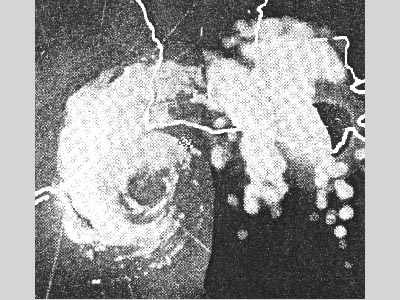This devastating hurricane developed from a tropical wave that moved across the Atlantic Ocean and Caribbean Sea during June 1957. Remaining undeveloped for that trek, the system finally began deepening over the Gulf of Mexico on the night of 24 June. The system was upgraded into a tropical depression on 25 June, as it stood stationary over the southwestern Gulf. It proceeded to develop very quickly, becoming a hurricane that day. On 26 June, as the storm began moving northward at a slow 8 km/h (5 mph), the precipitation field grew and it further intensified into a Category 2 hurricane on the Saffir-Simpson Hurricane Scale with winds of 169 km/h (105 mph). The hurricane’s forward motion then increased to 25 km/h (15 mph). This acceleration was accompanied by great intensification as the hurricane approached the U.S. coast. While at sea, the hurricane produced waves up to 15.2 meters (50 ft) in height. On 27 June, peak winds of 233 km/h (145 mph) were attained before Hurricane Audrey made landfall near the Texas/Louisiana border at that intensity. The hurricane pushed ashore a peak storm surge of 3.7 m (12 ft) that caused much destruction and took many lives. Storm surge of at least 1.8 m (6 ft) were experienced from Galveston, Texas to Cocodrie, Louisiana. Most of the 600 or more lives lost in relation to the hurricane were casualties of the storm surge. The water pushed many houses off their foundations and moved them many miles away. After the hurricane, most of these houses were found lining Louisiana’s Intracoastal Waterway. Other structures were simply smashed to bits. In Cameron, Louisiana, the only structure to survive the hurricane was the town’s courthouse. In fact, between 60 – 80 percent of all the homes and businesses within a 35 km (22 mi) stretch from Cameron to Grand Chenier were fully destroyed or badly damaged. More than 370 residents of this town perished when the storm surge pushed through. Over 1.6 million acres, up to 40 km (25 mi) inland, were flooded by the combined storm surge and river flooding.
Hurricane force winds extended from Port Arthur, Texas to Mobile, Alabama as Audrey came ashore. Because it was on the weaker, western side of the hurricane, there was only moderate damage in eastern Texas. This consisted of downed communication infrastructure and trees. Heavy rain fell over Texas. A daily rainfall record, which still exists today, of 18.67 cm (7.35 in) was set at Jefferson County Airport. Heavy rain also fell in Louisiana, with a maximum reading of 27 cm (10.63 in) in Basile. Several tornadoes touched down as well, one in New Orleans, which caused damage. After moving inland, Hurricane Audrey took a turn for the northeast and quickly weakened. It was extratropical by the time it crossed into Tennessee. The storm was able to re-strengthen as it moved through the Ohio River Valley as a function of extratropical processes. Winds as high as 161 km/h (100 mph) were reported at Jamestown, New York. Flooding occurred through the region, with the heaviest in Illinois and Indiana. The powerful and damaging storm was finally dissipated on 29 June Total storm damage amounted to $147 million (1957 USD, $1.1 billion 2010 USD). Fast Facts:
Sources:
“Hurricane Audrey.” Wikipedia. 2010. Web. Moore, Paul J. et al. “The Hurricane Season of 1957.” Monthly Weather Review. Dec. 1957. Web. Roth, David. “Louisiana Hurricane History.” National Weather Service. 2010. Pp 37-38. Roth, David. “Texas Hurricane History.” National Weather Service. 2010. Pp 48. Weather Underground. “Hurricane Audrey (06/25 – 06/29).” 1957 Storm Archive. 2010. Web. “Cameron, Louisiana.” Wikipedia. 2009. Web. |


